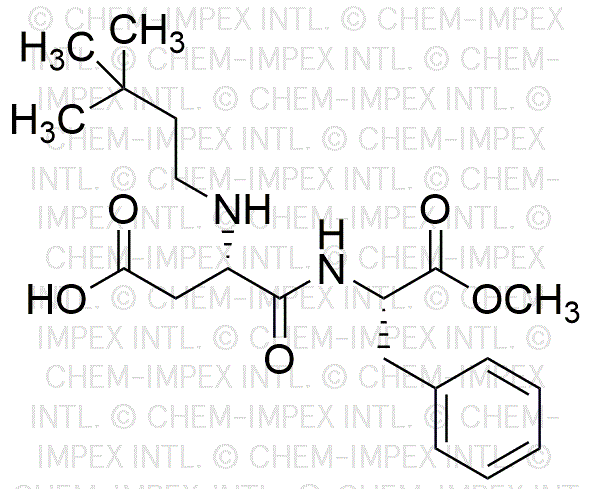Neotame is widely utilized in research focused on:
- Food and Beverage Industry: As a high-intensity sweetener, it is used in various food products, providing sweetness without the calories associated with sugar. This makes it ideal for low-calorie and sugar-free options.
- Pharmaceuticals: Neotame can enhance the palatability of medications, especially for pediatric formulations, making it easier for children to take their medicine.
- Dietary Supplements: It is often included in nutritional products to improve taste without adding calories, catering to health-conscious consumers.
- Cosmetics and Personal Care: The compound is also used in some cosmetic products to mask unpleasant flavors or odors, enhancing user experience.
- Research Applications: In scientific studies, neotame serves as a model compound for investigating sweetener interactions and metabolism, providing insights into dietary impacts on health.
General Information
Properties
Safety and Regulations
Applications
Neotame is widely utilized in research focused on:
- Food and Beverage Industry: As a high-intensity sweetener, it is used in various food products, providing sweetness without the calories associated with sugar. This makes it ideal for low-calorie and sugar-free options.
- Pharmaceuticals: Neotame can enhance the palatability of medications, especially for pediatric formulations, making it easier for children to take their medicine.
- Dietary Supplements: It is often included in nutritional products to improve taste without adding calories, catering to health-conscious consumers.
- Cosmetics and Personal Care: The compound is also used in some cosmetic products to mask unpleasant flavors or odors, enhancing user experience.
- Research Applications: In scientific studies, neotame serves as a model compound for investigating sweetener interactions and metabolism, providing insights into dietary impacts on health.
Documents
Safety Data Sheets (SDS)
The SDS provides comprehensive safety information on handling, storage, and disposal of the product.
Product Specification (PS)
The PS provides a comprehensive breakdown of the product’s properties, including chemical composition, physical state, purity, and storage requirements. It also details acceptable quality ranges and the product's intended applications.
Certificates of Analysis (COA)
Search for Certificates of Analysis (COA) by entering the products Lot Number. Lot and Batch Numbers can be found on a product’s label following the words ‘Lot’ or ‘Batch’.
*Catalog Number
*Lot Number
Certificates Of Origin (COO)
This COO confirms the country where the product was manufactured, and also details the materials and components used in it and whether it is derived from natural, synthetic, or other specific sources. This certificate may be required for customs, trade, and regulatory compliance.
*Catalog Number
*Lot Number
Safety Data Sheets (SDS)
The SDS provides comprehensive safety information on handling, storage, and disposal of the product.
DownloadProduct Specification (PS)
The PS provides a comprehensive breakdown of the product’s properties, including chemical composition, physical state, purity, and storage requirements. It also details acceptable quality ranges and the product's intended applications.
DownloadCertificates of Analysis (COA)
Search for Certificates of Analysis (COA) by entering the products Lot Number. Lot and Batch Numbers can be found on a product’s label following the words ‘Lot’ or ‘Batch’.
*Catalog Number
*Lot Number
Certificates Of Origin (COO)
This COO confirms the country where the product was manufactured, and also details the materials and components used in it and whether it is derived from natural, synthetic, or other specific sources. This certificate may be required for customs, trade, and regulatory compliance.


